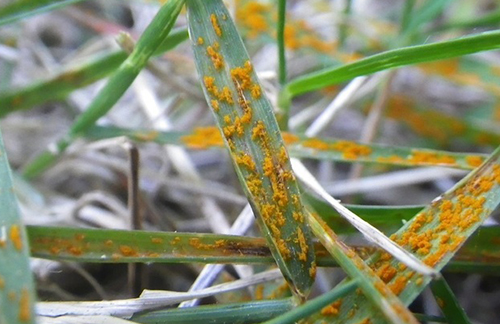Have you ever played with your dog in the lawn and you both end up with yellowish orange dust on your feet? You need to wipe off your shoes, and your dog looks like he's wearing Halloween socks. This situation is brought to you by lawn rust – not a welcome addition to any well-kept lawn. So, what exactly is lawn rust? What causes lawn rust? Is it dangerous to my yard? How do I get rid of rust in my lawn? Let's get started.
Identifying Lawn Rust
First things first, lawn rust is not actually rust. It’s a disease or infection of the grass blades caused by a fungus that develops during dry periods in the late summer and early fall.
Grass rust is easy to identify – simply pick a few blades of grass from your lawn and check them for an orangish-red or yellow-brown dust. You can usually see the rust spores on individual grass blades. If you run your finger across the grass, the lawn rust will wipe off. In extreme cases, you’ll notice patches of noticeably discolored grass.
Cool season grasses like Kentucky bluegrass, perennial ryegrass and tall fescue are often affected by lawn rust. These are the grasses that are grown primarily in Northeast Ohio.
Don’t worry – lawn rust is not harmful to humans or pets. However, lawn rust can make your lawn more prone to other issues because the grass is not as strong and healthy. It also can interfere with the ability of the grass to photosynthesize. The lawn rust can inhibit grass growth and cause it to have a “shredded appearance.”
Overall, lawn rust is a contributor to a less-than-healthy lawn, and in addition, it detracts from an otherwise beautiful lawn.
Let’s look at how to get rid of rust in your lawn.
Treating Lawn Rust Fungus
If you want to get rid of rust on your lawn, you probably also want to know how to prevent it entirely. This has a lot to do with outside circumstances. Most Ohio grass is prone to rust, and the weather we experience during late summer and autumn only makes the situation worse.
Dry weather can help lawn rust take hold and if your grass is low in nitrogen, it will be even more prone. But overwatering is also an issue.
Water your lawn in the morning instead at night. Watering your lawn in the evening, when the sun is not there to dry it during the day, can create the perfect conditions for lawn rust to take hold.
You should also take care of your lawn’s health with proper fertilizing and frequent mowing. To keep your lawn from collecting thatch that will also contribute to lawn rust, bag your lawn trimmings. Grass clippings can accumulate and affect the overall health of your lawn.
Core aeration can also assist in prevention of lawn rust. The practice of making small holes in the lawn for fertilizer to infiltrate better can help your grass stay strong and resist fungus growth. The combo of core aeration and fertilization is always key to a healthy lawn.
Grass Master Can Help Your Lawn
In most cases, lawn rust isn’t a serious problem. But if your yard becomes overrun with orange dust, the experts at Grass Master are here to help. Our lawn care packages are designed to give you the lawn of your dreams. Contact us for more information.

